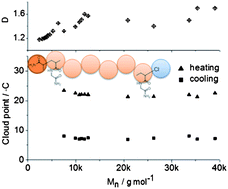Atom transfer radical polymerization as a tool for making poly(N-acryloylglycinamide) with molar mass independent UCST-type transitions in water and electrolytes
Abstract
Atom transfer

* Corresponding authors
a
University of Bayreuth, Macromolecular Chemistry II, Bayreuth Center for Colloids and interfaces, Universitätstrasse 30, D-95440 Bayreuth, Germany
E-mail:
agarwal@uni-bayreuth.de
Fax: +49-921-553393
Tel: +49-921-553397
b Fb. Chemie, Philipps-Universität Marburg, Germany
Atom transfer

 Please wait while we load your content...
Something went wrong. Try again?
Please wait while we load your content...
Something went wrong. Try again?
F. Liu, J. Seuring and S. Agarwal, Polym. Chem., 2013, 4, 3123 DOI: 10.1039/C3PY00222E
To request permission to reproduce material from this article, please go to the Copyright Clearance Center request page.
If you are an author contributing to an RSC publication, you do not need to request permission provided correct acknowledgement is given.
If you are the author of this article, you do not need to request permission to reproduce figures and diagrams provided correct acknowledgement is given. If you want to reproduce the whole article in a third-party publication (excluding your thesis/dissertation for which permission is not required) please go to the Copyright Clearance Center request page.
Read more about how to correctly acknowledge RSC content.
 Fetching data from CrossRef.
Fetching data from CrossRef.
This may take some time to load.
Loading related content
